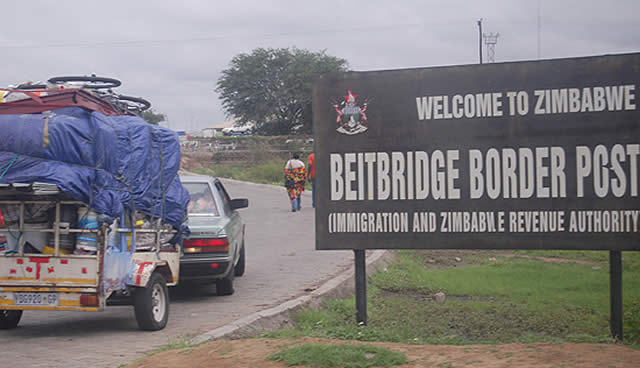Time to operationalise National Ports Authority

Thupeyo Muleya, Beitbridge Bureau
Zimbabwe will re-open its land borders on December 1 to passenger traffic in a phased model starting with private motor vehicles and pedestrians.
Public transport is expected to start moving through the borders in the first quarter of next year.
The borders were closed to passenger traffic at the peak of the Covid-19 pandemic that has swept across the world.
During the intense lockdowns, only commercial cargo, bodies for burial and diplomats on Government business were allowed access through the borders subject to screening by port health officials.
One of the major border posts set to open to passenger traffic is Beitbridge which, under normal circumstances, sees through 8 million people from across Sadc annually and 30 000 at peak daily.
Through the Zimbabwe is open for business mantra, the Government has been rolling out a number of initiatives to make travelling and regional, and international trade seamless.
These include the upgrading of the Robert Mugabe International Airport and the modernisation of the Beitbridge border post at a cost of US$241million and reaffirmation of the introduction of a one-stop border post (OSPB) concept at Beitbridge. Under the OSPB the two countries sharing a border harmonise operations to simplify the way of business and travellers are cleared once for passage into either country.
Sadc chose Beitbridge for a OSBP in 2006.
In 2009 the Common Market for East and Central Africa (Comesa) launched the Chirundu OSBP by Zimbabwe and Zambia.
While the Chirundu project has progressed, the Beitbridge one has failed to take off due to a number of challenges, among them bureaucracy on both sides – Zimbabwe and South Africa – and the shortage of infrastructure.
In addition, the lack of a border controlling authority on the part of Zimbabwe has derailed the take-off of the noble initiative, and the improvement on the ease of doing business.
In the last decade, the situation at Beitbridge had become chaotic, though it has relatively improved over the last three years.
Under current lockdown protocols the border sees through 1 300 commercial trucks, 1 000 travellers and very few light vehicles, but the operational challenges persist.
At the height of the chaos, the volume of travellers and importers using the port dwindled as the border turned free for all with dozens of border agencies implementing varied programmes more often conflicting each other.
Such a scenario presents a nightmare for people to import or export goods with most travellers and importers pointing fingers to the stakeholders at the border chief among them the Zimbabwe Revenue Authority (Zimra).
However, Zimra says some of the delays were a result of human resources shortages.
This shortage of manpower has also given leeway to the current crop of border authorities who extort money from stranded travellers in order to expedite services.
Chronicle understands that though there is a Border Efficiency Committee at Beitbridge, issues to do with operations coordination and accountability are still a challenge.
This has created room for rent-seeking activities and inefficiency, and people are finding it difficult to raise issues of concern in a set-up where there is no one in charge of the place or any authority superintending operations.
Presently the movement of both commercial cargo and people on cross-border buses is chaotic and this calls for the Government to do a lot of soul searching before December 1.
There are a lot of health and operational matters needing urgent attention from a central coordinator, who will have an oversight role to all administrative and operational issues.
Issues that need attention include the setting up of automated thermometers and sanitisers at the entrance of all border buildings as well as the introduction of wheel and foot baths for people entering and leaving the border.
The Government also needs to open a well-stocked testing and screening facility within the border post and avail more manpower and personal protective equipment to protect the frontline workers at the check point.
The current scenario, where health officials have to take samples for further Covid-19 testing to Gwanda and Bulawayo has to be addressed timeously considering the workload at the country and Sadc’s busiest inland port of entry.
It is important for Zimbabwe to reorganise itself to avoid clogging the border with vehicular and human traffic because of low testing capacity. Considering that December is the peak of the travelling season, more walking booths, independent of the main immigration hall, are needed at Beitbridge Border Post.
This should be done to accommodate many of the pedestrians who are usually assisted outside the main buildings.
The state of affairs at the border presents an ideal environment for the Government to now move faster to operationalise the envisaged National Ports Authority (NPA) to coordinate operations and efficiently attend to traditional challenges at the port of entries, just like what is happening in South Africa.
Such a ports authority will deal with operations, administrative, security and health matters, among others.
Some of the stakeholders at the border posts currently include Department of Immigration, Zimra, police, ministries of Health, Environmental Management Authority, Forestry Commission, Transport, Veterinary Services and security agencies. There is also a need to synchronise these operations to minimise the number of checkpoints and the processes business traffic or travellers go through. -@tupeyo









Comments